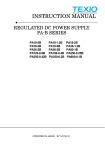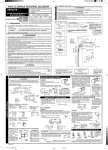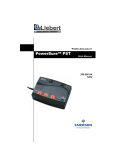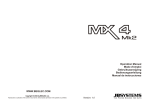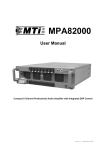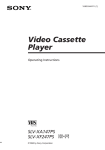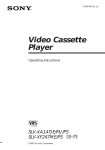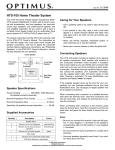Download Thule PR350 User's Manual
Transcript
Owners manual SPACE PR350 B V350 Manufactured under license from Dolby Laboratories. ”Dolby”, ”ProLogic II” and the double-D symbol are trademarks of Dolby Laboratories. Confidential unpublished works. © 1992-1997 Dolby Laboratories Inc. All rights reserved. Manufactured under license from Digital Theater Systems, Inc. US Pat. No. 5,451,942, 5,956,674, 5,974,380, 5,978,762 and other world-wide patents issued and pending. "DTS", "DTS-ES Extended Surround" and "Neo:6" are trademarks of Digital Theater Systems, Inc. Copyright 1996, 2000 Digital Theater Systems, Inc. All Rights Reserved. Thule Audio ApS has the right to make changes without prior notice INDEX OVERVIEW OF REMOTE CONTROL......................................................................................................... 4 OVERVIEW OF REAR AND FRONT PANEL ............................................................................................. 5 OVERVIEW OF CONTROL PANEL AND DISPLAY ................................................................................. 6 CONGRATULATIONS WITH YOUR NEW PREAMPLIFIER/PROCESSOR SPACE PR350 B. ......... 7 0. INSTALLATION ........................................................................................................................................... 9 1. INPUT SELECTION ..................................................................................................................................... 9 2. VOLUME CONTROLS .............................................................................................................................. 10 3. ZONE 2 ......................................................................................................................................................... 11 4. DELAY ......................................................................................................................................................... 11 5. SURROUND MODES ................................................................................................................................. 13 5.1 DOLBY DIGITAL ....................................................................................................................................... 13 5.2 DTS ......................................................................................................................................................... 14 5.3 DOLBY PROLOGIC II ................................................................................................................................ 15 5.4 PCM AND ANALOGUE INPUTS .................................................................................................................. 15 5.5 SIDE CHANNELS ....................................................................................................................................... 16 6. CONFIG MENU .......................................................................................................................................... 16 6.1 SPEAKERS ................................................................................................................................................ 17 6.2 INPUTS ..................................................................................................................................................... 18 6.3 NOISE ....................................................................................................................................................... 18 6.4 CROSSOVER FREQUENCY .......................................................................................................................... 18 6.5 EXTENDED SURROUND ............................................................................................................................. 18 6.6 DYNAMIC RANGE COMPRESSION ............................................................................................................... 18 6.7 VOLUME SCALE ........................................................................................................................................ 19 6.8 SAVING SET-UP PARAMETERS IN MEMORY ................................................................................................ 19 6.9 RETURN TO FACTORY SETTING ................................................................................................................. 20 6.10 OSD....................................................................................................................................................... 20 6.11 SPDIF OUT........................................................................................................................................... 20 6.12 POWER AMP CONTROL ........................................................................................................................... 20 6.13 PROLOGIC II .......................................................................................................................................... 20 6.14 VIDEO INPUT OUTPUT ............................................................................................................................. 21 6.15 VIDEO MISCELLANEOUS.......................................................................................................................... 21 TECHNICAL SPECIFICATIONS................................................................................................................. 22 7.0 YOUR NOTES ........................................................................................................................................... 23 APPENDIX A: SPECIAL FUNCTIONS ....................................................................................................... 24 A.1 COMMUNICATION BETWEEN PR350 B AND IA/PA350 B/PA250 B ........................................................ 24 OVERVIEW: COMMUNICATION BETWEEN PR350 B AND PA350 B.................................................................. 25 A.2 A/D LEVEL ............................................................................................................................................. 26 A.3 ELECTRICAL (COAXIAL) VERSUS OPTICAL DIGITAL INPUT. ........................................................................ 26 A.4 AUTOMATIC FAILURE CORRECTION SYSTEM............................................................................................ 26 ___________________________________________________________________________ page 3 REMOTE CONTROL STBY MUTE VOL standby | mute -20dB | increase volume DIM VOL VOL change light | return to master volume | decrease volume left | center | right L C R SL SUB SR surround left | subwoofer | surround right DVD SAT TV DVD player | sattelite receiver | TV-set channel balance double push: delay input selection received input status LD TAPE 1 TAPE 2 [STATUS] laser disc | audio/video tape1 | audio/video tape2 PURE A. pure audio input [CONFIG] enter config mode ENTER change surround mode [MODE] navigate in config menu analog audio inputs to DSP composite video inputs S-video inputs volume control | control panel: see next page display: see next page FRONT PANEL AND REAR PANEL main function / function in config mode VOL short push: back to master volume 2 sec. push: enter config mode / exit config menu SURROUND short push: change surround mode 2 sec. push: input format information MODE VOL digital surround SURROUND MODE DTS R SR short push: surround right channel balance 2 sec. push: surround right channel delay SR short push: surround left channel balance 2 sec. push: surround left channel delay / enter SUB SUB SL SL R right channel balance / right C short push: center channel balance 2 sec. push: center channel delay / up C L left channel balance / left Adjustments Zone 2 2 channel stereo L ZONE 2 STEREO ZONE 2 STEREO standby indicator short push: subwoofer balance 2 sec push: LFE balance / down surround surround Dolby ProLogic II Dolby Digital volume level 100: max 0: min surround mode TV-set TV LD MUTE/ STBY PURE AUDIO PURE AUDIO short push: mute -20dB 2 sec push: standby pure audio input MUTE/ STBY DISPLAY CONTROL PANEL TAPE 2 audio/video tape2 laser disc player or CD player TAPE 2 TAPE 1 sattelite receiver LD TV SAT SAT DVD TAPE 1 audio/video tape1 DVD player DVD remote sensor multi functional display Congratulations with your new Preamplifier/Processor SPACE PR350 B. The SPACE PR350 B contains advanced technology for an outstanding range of features and sound performance. We are sure that the PR350 B will give you long lasting pleasure. To give you full benefit from this advanced product, please read this manual carefully before you proceed. The SPACE PR350 B contains following features: - Pure analogue input with 6 channels and true balanced signal path in the L and R channels 32 – 96 kHz PCM stereo 96kHz Dolby ProLogic II decoding Dolby Digital decoding with auto detection DTS 5.1, DTS 6.1 discrete, DTS 6.1 matrix and DTS 24bit/96kHz decoding with auto detection Extended precision decoder improves dynamic range for 24bit DTS up to 117dBA - New 56367 Motorola DSP with 160 MIPS (Million Instructions Per Second) Upgradable design for coming sound formats 10 pcs. Burr Brown 24bit/192kHz D/A converters True differential D/A conversion in all channels, - Direct key access to channel trim adjustments with 0.5dB adjustment step Precision volume control for all 10 channels with 0.5dB adjustment step and 100dB range Delay adjustment for center, surround left, surround right and surround center channels Common delay (Lip sync) for all channels up to 5ms. Direct key access to input selection Most inputs can be assigned as analogue, electrical digital or optical digital Sensitivity for analogue inputs to DSP is adjusted automatically for improved dynamic range Test Noise signal in all channels including subwoofer, to set up volume trim. Component, S-video and composite video switching with 4-line adaptive comb filter, so that only one RGB or Component video connection to TV / Projector is necessary. Progressive video pass-through with 100MHz bandwidth Video encoder with On Screen Display (OSD), which is automatically bypassed when not used - Flexible speaker settings with extensive bass management Adjustable crossover frequency (60 – 120Hz) for bass management Dynamic range compression for both DTS and Dolby Digital, e.g. for improved performance in noisy environments Each feature is described further in the next pages. ___________________________________________________________________________ page 7 Following formats are used: Cursive text indicates display readout, e.g.: CONFIG Key type is indicated with “”, e.g.: “ENTER” key. Stereo speakers: “L” : left speaker “R” : right speaker Surround speakers: “C” : center speaker placed in front of the listening position “SL” : surround left speaker placed rear left of the listening position “SR” : surround right speaker placed rear right of the listening position Extended surround speakers: “SC” : surround center speaker placed back of the listening position. “SSL” : reserved for future upgrade. Output L channel. “SSR” : reserved for future upgrade. Output R channel. ___________________________________________________________________________ page 8 0. Installation Place the amplifier on a hard and flat surface. The ventilation holes should not be covered. There has to be at least 5 cm (2 inches) free air on top of the amplifier. To ensure long and trouble free operation we recommend: - Do not expose the amplifier to direct sunlight. - Do not place the amplifier in warm or dusty environments. Caution: Because of risk of fire or electric shock, do not expose the amplifier to rain or moisture. Caution: Because of risk of electric shock, do not open the amplifier. 1. Input selection The input selection is very flexible, so it can suit many different home theatre and stereo installations. It is possible to switch between seven different inputs, which are directly accessed by keys on the front panel or on the remote control. Each input can be configured in different ways, shown below with an “X”. The factory settings are marked with [ ] brackets. Changes to this setting can be made under the config.input menu. INPUTS DVD Analogue Coax digital [X] Dig. Direct X Optical X Com.video SAT LD TV Tape 1 Tape 2 Pure A. X X [X] [X] [X] [X]* [X] [X] X X [X] X [X] X [X] X [X] S-video X X Component [X] X [X] *The Pure Audio input can be either XLR stereo or 6 channel RCA phono input. For the audio signals, one of four options in the upper three rows must be selected under the config.input menu. Similarly, the video inputs configuration must be selected for PR350B in the config.video-input-output menu. After video switching, the built-in adaptive comb filter converts the selected video source into component or RGB video format. Therefore, your projector or TV must be set correctly to either RGB or component, and the “intelligent” video switching in your PR350B will take care of the rest. The Pure Audio input can be selected as both XLR balanced or unbalanced phono input. A short push on the “PURE AUDIO” key selects the XLR input. By holding down this button down for more than one second or double push on the remote control, you select the Pure Audio phono input. The Pure Audio input will bypass the DSP circuits and is recommended for high quality music listening in stereo e.g. from CD player or other analogue source. Alternatively, for high quality music listening in stereo, connect the digital output from ___________________________________________________________________________ page 9 a CD player or DVD player to one of the available digital inputs in the PR350 B and use the balanced 24bit D/A conversion for L and R channels, built into the PR350 B. The Space PR350 B is also optimised for D/A conversion of the 24bit/96kHz stereo DVD disc’s with music. 2. Volume controls The master volume level is set by rotating the volume knob on the front panel or by using the “VOL ⇑” or VOL ⇓” key on the remote control. The volume adjustments are scaled, so that at normal listening levels, the setting is very accurate with 0.5dB steps, while at lower levels the step size increases to allow a more rapid setting. This scaled volume setting may be the most convenient for normal users, and is set as default. However, it is possible to change the volume to 0.5dB steps for the entire volume range by changing it in the config.volume menu. The volume trims between each channel are set under the config.noise menu by comparing the perceived sound volume from each channel via the built-in noise generator, so that you can compensate for speaker sensitivity differences and distances from listening position. We recommend that the settings for each channel obtained under the config.noise option are used as initial settings for each of the memory banks: Stereo, ProLogic II, Dolby Digital and DTS. See further descriptions about the mem banks in section 5. However, each surround mode may lead to a different setting of volume trims based on individual requirements. At Thule Audio’s experience in Dolby Digital and ProLogic II mode, the gain can be increased 3 – 6 dB in the surround speakers than “measured” under the noise test, to obtain a more realistic surround image. And also in DTS mode the gain can be increased with 2 – 4 dB in the surround speakers. These more practical settings based on individual requirements can then be stored under each memory bank for automatic reload depending on actual surround mode. Each movie or music source may also lead to a different setting of volume trims. Therefore it is possible to adjust the volume trim “on the fly” directly by pushing the channel “L”, “C”, “R”, “SL”, “SUB” or “SR” key on the front panel or remote control. Subsequently the extended surround channels “SC”,”SSL” and “SSR” can be selected for adjusting by using the arrow keys. The channel level can then be adjusted by rotating the volume knob on the front panel or by pressing the “VOL ⇑” or VOL ⇓” key on the remote control. The volume trim settings changed “on the fly” will return to the default settings stored in the memory banks, when the PR350 B is set into standby or powered off. By pushing the “SUB” key on the front panel in for 2 seconds the LFE (low frequency effect) channel is selected for adjusting. The LFE channel is the bass information, which is sent to the subwoofer or alternatively sent to the “L” and “R” channels, if the subwoofer is deactivated. In this way it is possible to adjust the low frequency content even when no subwoofer is present. The normal display returns 15 sec. after the last action on any of the channel select keys or by pushing the ”>VOL” key. ___________________________________________________________________________ page 10 3. Zone 2 With zone 2 it is possible to redirect the sound to other audio systems, e.g. placed in kitchen or bedrooms. The zone 2 has separate volume control and input selector. Adjustments for zone 2 are achieved by holding down the same input knob as currently selected. E.g. when DVD input is selected, hold down the “DVD” knob on remote or frontpanel, approx. 1 sec. Then the ZONE2 indicator becomes active. Possible inputs are: SAT ANLG TV ANLG LD ANLG TAPE1 ANLG Z1 -> Z2 (Input selected in the main zone is played in zone 2) Even if an input is defined as digital in the main zone, the analog option is chosen in zone 2. The operation returns to the main zone 15 sec. after the last adjustment in zone 2 or by pushing the ”>VOL” key. 4. Delay To experience the best surround sound quality, it is important that the sound signal from all the speakers arrives at the same time at the listening position. If the listening position is placed closer to the rear surround speakers, the sound from these speakers will arrive earlier at the listening position. In this case, it is necessary to delay the sound slightly from the rear speakers. The important issue here is the difference in distance from the listening position to the front and rear speakers. The same problem arises for the center speaker, if it is placed closer to the listening position than the front speakers. On some video sources, the video is delayed compared to the audio, due to video processing. To compensate for video delay it is possible to delay all audio channels up to 5ms. This common delay is called “Lip sync”. The delays are set directly from the front panel keys by pushing the “SL”, “SR” or “C” keys for more than two seconds or double push on the same knobs on the remote control. The display corresponds shortly with the message DELAY and afterwards the delay setting for the selected channel is displayed, e.g. SL 5.0ms. Subsequently the delay of the extended surround channel SC and “Lip Sync” can be selected by using the arrow keys. The delay can then be changed in steps of 1.0ms by turning the volume knob or pressing the “VOL ⇑” or “VOL ⇓” key on the remote control. The normal display returns after 15 seconds from last change or by pushing the “>VOL” key. The setting is expressed in milliseconds, but the delay can be calculated from the physical distance. ___________________________________________________________________________ page 11 A sound wave travels at approx. 340 meter/sec., which is equivalent to: 1 foot in 1 millisecond 1 meter in 3 milliseconds or Following example demonstrate how to calculate the delay setting for SL, SR, SC and C: From the listening position to each speaker, we measure following distances: Listening position <-> Left speaker: Listening position <-> Right speaker: Listening position <-> Center speaker: Listening position <-> Left surround speaker: Listening position <-> Right surr. speaker: Listening position <-> Center surr. speaker: Example Your measurements 3.8 m (= 11.4 ft) 3.8 m (= 11.4 ft) 2.9 m (= 8.7 ft) 2.1 m (= 6.3 ft) 2.1 m (= 6.3 ft) 1.8 m (= 6.3 ft) The delays when measuring the distance in meters are then calculated as: SL delay : SR delay : C delay : SC delay : (L - SL distance) x 3 = (R - SR distance) x 3 = (L - C distance) x 3 = (L - C distance) x 3 = (3.8 - 2.1) x 3 = (3.8 - 2.1) x 3 = (3.8 - 2.9) x 3 = (3.8 - 1.8) x 3 = 5.1ms 5.1ms 2.7ms 6ms or when the distance is measured in feet: SL delay : SR delay : C delay : SC delay : L - SL distance = R - SR distance = L - C distance = L - SC distance = 11.4 - 6.3 = 11.4 - 6.3 = 11.4 - 8.7 = 11.4 - 5.4 = In this example, we would set the delay to: SL 5.0ms C 3.0ms SR 5.0ms SC 5.1ms 5.1ms 2.7ms 6ms 6.0ms The above calculations for delay are based on the physical installation and should be stored as the initial settings in the memory banks (see section 5). However, at Thule Audio’s experience the delay could be further increased about 0 – 3 milliseconds in the surround speakers from the above calculations, to obtain a more realistic surround sound image. For each surround mode the preferred settings should be stored in the memory banks for automatic reload. ___________________________________________________________________________ page 12 The user may still prefer to change delays during playback of a movie, based on subjective preference in a specific movie. Hence the delay can also be set “on the fly”. The intermediate delay settings will return to the default settings stored in the memory banks when the PR350 B is set into standby or powered off. 5. Surround Modes The actual surround mode of the PR350 B is always indicated in the display: Possible input types: analogue input, PCM or Dolby Digital 2.0 bitstream analogue input, PCM or Dolby Digital 2.0 bitstream Dolby Digital 5.1 bitstream. DTS bitstream: 5.1, ES 6.1 discrete or 96kHz 5.1 - Stereo - Dolby ProLogic II - Dolby Digital - DTS 5.1 Dolby Digital If a Dolby Digital 5.1 surround bitstream is detected, the PR350 B will automatically switch to Dolby Digital surround and the Dolby Digital indicator will light up. By pushing the “SURROUND MODE” key on the front panel or “mode” on the remote control, information about which outputs can be expected to be active, are indicated, thus: L: R: C: SC: SL: SR: SW: left speaker right speaker center speaker surround center speaker surround left speaker surround right speaker subwoofer The number of active outputs will depend on which speakers are activated in the config.speaker and config.extended surround menu, received input type (analogue, PCM, Dolby Digital bitstream or DTS bitstream) and eventually the selected surround mode. By pushing the “SURROUND MODE” key for more than one second, information about the received bitstream will be displayed: Active audio channels in the received bitstream: 2/0 2/1 2/2 3/0 3/1 3/2 : : : : : : L, R are present L, R, S are present* L, R, SL, SR are present* L, R, C are present* L, R, C, S are present* L, R, SL, SR, C are present* *If not all speakers are selected under the config.speaker menu, down mixing will occur. ___________________________________________________________________________ page 13 And the transmission bit rate of the received bitstream: 32k : 32 kbit/sec. . . 448k : 448 kbit/sec. 768k : 768 kbit/sec. (only DTS) 1411k : 1411 kbit/sec. (only DTS) 1532k : 1532 kbit/sec. (only DTS) If only two audio channels are active in the received Dolby Digital bitstream (2/0), the input is assumed to be Dolby ProLogic II, if indicated in the bitstream, otherwise as two channel stereo. In case of only two audio channels are active, the user can toggle between STEREO and Dolby ProLogic II by an additional short push on the “SURROUND MODE” key. In this case both the Dolby Digital and Stereo or the Dolby Digital and Dolby ProLogic II indicators are turned on. See further information about ProLogic II below. The normal display returns after 15 sec. from last push on “SURROUND MODE” or by pushing the ”>VOL” key. 5.2 DTS Generally DTS offer the same information and possibilities as described above for Dolby Digital. But DTS also contains additional possibilities as described in the following. Several new DTS formats are supported: DTS 24bit: The DTS encoding resolution is indicated at DTS lock on, second line. E.g. 768k/24 means a 768kHz transmission bitrate with a 24bit encoding resolution. PR350 B offer extended precision decoding of DTS 24bit stream to take full advantage of this increased resolution. This improves dynamic range for DTS 24bit of up to 117dBA, which is fully comparable with DVD Audio. But DTS 24bit stream can be played on normal DVD Video players. Several mainstream DVD Video disc’s are already encoded with DTS 24bit, e.g.: “Pearl Harbour”, “Jurassic Park III”, ”Gladiator”, “Bowfinger” and “The Haunting”. DTS ES 6.1 Discrete and DTS ES 6.1 Matrix: Some DTS disc’s are encoded with a discrete center surround channel, called “6.1 Discrete”. If such DVD disc’s are played, PR350B will indicate ES 3/3.1 at lock on. This means three front channels (L, C, R) and three surround channels (SL, SC, SR) are present in the DTS stream. If “6.1 Discrete” is enabled under the config.extended surround menu, the PR350B will automatically activate the extended surround channel, SC. Examples of DTS ES 6.1 Discrete DVD disc’s are “Gladiator” and “The Haunting”. A few other DVD disc are encoded with DTS ES 6.1 Matrix, where the extended surround channel, SC is generated by a matrix process on the surround channels, SL and SR. An example of DTS ES 6.1 Matrix disc is “Terminator II, special edition”. ___________________________________________________________________________ page 14 DTS 6.1 Compatible: This DTS mode is actually identical to DTS ES 6.1 Matrix as described above, but by enabling this mode the user choose always to activate the matrix process on the SL and SR to generate the SC channel. DTS 6.1 Compatible will work on Dolby Digital 5.1 streams, too. Try out e.g. the “Black Hawk Down” disc. If the installation contains three surround channels, 6.1 Compatible will improve the surround experience on nearly all 5.1 encoded music and movie CD/DVD disc’s. Also 6.1 Compatible will generate the same sound information in the SC channel as the THX Surround EX process. In this case the user should enable both “6.1 Discrete + Matrix” and “6.1 Compatible” under the config.extended surround menu. DTS 96kHz: DTS offer a new format, also supported by PR350 B, where D/A conversion takes place at 96kHz. The encoding resolution is also 24bit, thus the format is normally referred to as “DTS 24/96”. PR350 B will automatically detect this type of bitstream and display 96k 5.1. No interaction from the user is necessary. The 6.1 Compatible mode is automatically disabled and no sound comes from the SC channel in 96kHz mode. The “Queen: A night at the opera” CD in DTS 24/96 demonstrates the usefulness of this format. The DTS 24/96 format is compatible in performance with DVD Audio, but can be played on normal CD or DVD video players. 5.3 Dolby ProLogic II The PR350 B support the new format ProLogic II, which generate surround and center channels from a normal stereo signal. Compared with the conventional ProLogic, the new ProLogic II among other things offers, separate SL and SR channels with full bandwidth information. PR350 B supports separate music and movie mode for ProLogic II. The normal movie mode concentrate to much information in the center channel for music, therefore the special music mode spread out the music in the center channel to the L & R speakers. Thule Audio finds the music mode very useful especially for some live recordings, but it is also a matter of taste, if it is used. For each input the user can decide by default , if Music or Movie mode, or no ProLogic II is activated, under the config.ProLogic II menu The surround mode can be toggled between STEREO and Dolby ProLogic II by an additional short push on the “SURROUND MODE” key. As a unique feature in PR350 B, ProLogic II is supported for 96kHz sample rate. This is useful as the high quality A/D converter in PR350 B operates at 96kHz and also some DVD’s operate at 96kHz. 5.4 PCM and analogue inputs An analogue input is present if the letters “ANLG” is indicated after the source name, e.g. LD ANLG. A PCM input is present, if a Dolby Digital or DTS stream is not auto detected for a digital input (COAX or OPTO). ___________________________________________________________________________ page 15 An analogue or PCM input stream contains no information about the surround mode, therefore STEREO is selected as default, if ProLogic II is not selected under the config.ProLogic II menu. By pushing the “SURROUND MODE” key for more than one second or “STATUS” on the remote control, information about received bitstream will be displayed, e.g. PCM. The PR350 B can receive PCM inputs with sampling rates from 32kHz up to 96kHz. For analogue inputs going through the DSP, PCM will also be displayed because the digital data from the analogue to digital converter (A/D) is in PCM format with 96 kHz sampling rate. For the “PURE AUDIO” input, only ANALOG is displayed, because this input bypasses the DSP circuits. The normal display returns after 15 sec. from last push on “SURROUND MODE” or by pushing the ”>VOL” key. 5.5 Side Channels Thule Audio offers a unique 8.1 channel extension setup for large rooms: Side channels. By blending the sound from the front speakers and the rear speakers into to new channels called SSL and SSR, it is possible to create a more continuous sound sweep for sound effects moving from one end of the room to the other. The side speakers are simply activated in the config.extended surround menu. 6. Config menu The config menu is activated by pushing “CONFIG” on the remote control or holding the “>VOL” key in for 2 seconds on the front panel. Navigation through the config menu with the remote control is possible with the arrows: ⇑ ⇓ ⇒ ⇐ A sub menu is entered by pushing “⇒”. Options are selected by pushing “enter”. Selected options are underlined on the front panel display and highlighted on the OSD screen. Exit from a sub menu is done with “⇐ ”. It is also possible to navigate in the config menu with the front panel keys, as these keys are reassigned in the config mode: “L”: ⇐ “SL”: enter “C”: ⇑ “SUB”: ⇓ “R”: ⇒ It is possible to exit the config menu by additional pushes on the “⇐” key, or one push on the “>VOL” key. The config menu has two pages, page 2 is displayed by additional push on the ⇑ or ⇓ key. In the config sub menus several settings are possible as described in the following paragraphs: ___________________________________________________________________________ page 16 6.1 Speakers The SPACE PR350 B contains extensive bass management adjustments, so that the bass signal can be re-routed to those loudspeakers capable of handling the low frequency information. The following selections can be made in the config.speaker menu by using navigation keys described above: Left speaker (L): Right speaker (R): Center speaker (C): Surround left speaker (SL): Surround right speaker (SR): Subwoofer (SUB): SMALL or LARGE SMALL or LARGE SMALL or LARGE or OFF SMALL or LARGE or OFF SMALL or LARGE or OFF ON or OFF The bass signal directed to speakers selected as SMALL, will be re-routed to the subwoofer, or the L,R speakers (bass management). If a speaker is turned off, the sound signal will be sent to the remaining speakers, which are selected as active (down mixing). - Special attention should be given to the subwoofer management: For Dolby Digital 3/2 and DTS input stream a special low frequency channel (LFE) is normally included, which is indicated with a “.1” after the input stream indication, e.g. 3/2 .1 . The LFE channel produces an output at the subwoofer. That means even if all speakers are chosen LARGE, where no signal is send to the subwoofer by the bass management, signal will be send to the Subwoofer from the LFE input channel. For Stereo and ProLogic II no LFE channel is present. And if all speakers are chosen LARGE, the bass management does not send any signal to the subwoofer. In this case to have a subwoofer signal, the user can select the subwoofer – max bass ON option under the config.cross freq menu. In this case PR250 B takes the summed full range signal from the L and R channels and send to the subwoofer. In case of using subwoofer (subwoofer is activated) in Stereo and Pro Logic mode, the user should therefore decide: a ) Select L and R (or L,R,C,SL,SR in Pro Logic) to be SMALL. Then the low frequencies will be send to the subwoofer by the bassmanagement. The crossover frequency is set in the config.cross freq menu. or b) Select L and R (or L,R,C,SL,SR in Pro Logic) to be LARGE and then select Subwoofer – max bass ON in the config.cross freq menu. In this case the full range summed mono signal from the other channels, will be send to the subwoofer. The implication of b) is that “double bass” is present in the system. That means the user should eventually chose a lower gain setting for the subwoofer, e.g. –4 to –8 dB depending on the sensitivity of the subwoofer relative to the other speakers. ___________________________________________________________________________ page 17 The b) situation can be useful in situations, where the L, R speakers can handle deep bass information and extra bass is required. If the L and R speakers are not so well suited for the lowest frequencies, then chose a), eventually with lowest 60Hz cross over frequency. Further the Subwoofer – max bass ON can be selected in the Dolby Digital and DTS mode if extra bass is required. The Subwoofer – max bass setting will be stored in the memory bank and can therefore be set individually for each surround mode. 6.2 Inputs Assignment of socket for each input can be selected in this menu as previously described in section 1. 6.3 Noise If different speakers are used or the distance from the listening position to each speaker is different, the perceived sound level at the listening position from each speaker will change. By selecting the NOISE option, a noise signal is sent to each activated speaker. The noise signal will cycle around and the user should set the level for each speaker to obtain equal sound level at the listening position. A sound pressure level meter can be used if required - use the "C" weighted setting, and hold the meter away from the body. Exit from noise test: push “⇐” or “>VOL” keys. 6.4 Crossover frequency A very useful feature is the Cross frequency setting. If a speaker is selected as small, the low frequency content is sent to the Subwoofer and/or L/R speakers. The corresponding crossover frequency is selected under the config.cross freq menu. Small surround speakers could be selected as high as 120Hz, but larger speaker should be 60Hz. 6.5 Extended Surround In this menu you can enable DTS ES 6.1 Discrete + Matrix and DTS 6.1 Compatible. Please refer to “Surround mode” section for explanations. 6.6 Dynamic range compression When playing in a noisy environment, it may be desirable to boost the low level signals, to be able to hear the low level signals at realistic average sound levels (e.g. the sound of the leave rustling in the wind). Further the low level boost can increase understanding of speech, especially in noisy environments. It may also be desirable to limit the peak sound level, not to disturb neighbours at night. ___________________________________________________________________________ page 18 The following settings are possible: DYNAMIC HI (DTS + Dolby Digital) High level limit: 0.0 (disable high level limit function) 0.1 0.2 0.4 0.6 1.0 (maximise high level limit function) DYNAMIC LO (Dolby Digital) Low level boost: 0.0 (disable low level boost) 0.1 0.2 0.4 0.6 1.0 (maximise low level boost) 6.7 Volume scale It is possible to select two volume level settings: a progressive step size, where step size is large at low levels for rapid setting and small at normal listening levels, or a fixed 0.5 step size. The progressive step size will be most convenient for most users and is therefore called “normal” and selected as default, while the fixed step size is called “full”: “normal”: 0.0, 5.0 , 10.0, 15.0, 20.0, 22.0, 24.0,......38.0, 40.0, 41.0, 42.0,..... , 68.0, 69.0, 70.0, 70.5, 71.0, 71.5, .... , 99.5, 100 “full”: fixed 0.5 dB step size from 0.0 to 100 ( 200 steps). 6.8 Saving set-up parameters in memory In the menu MEM BANK, it is possible to store the set-up parameters in four memory banks, one for each surround mode: Stereo, ProLogic II, Dolby Digital and DTS. Following parameters are saved: - Channel volume trims (L, C, R, SL, SR, SUB and LFE) Channel delay (SL, SR, C, SC) Speaker configuration When you have completed your settings for one of the four above mentioned modes, you can save your settings by choosing the correct memory bank (Stereo, ProLogic II, Dolby Digital or DTS) by pressing “⇒ “ and then press “ENTER”. The saved parameters will be reloaded each time a surround mode is changed. However, intermediate settings made “on the fly” will be maintained for each surround mode until the PR350 B is powered off or set into standby. ___________________________________________________________________________ page 19 6.9 Return to factory setting Each setting in the configuration menu will be stored even if the power is removed. However, if your entire set-up doesn’t work well, it may be desirable to reload the original factory settings. If this option is selected by the ”⇒” key, the user will be asked SURE ? in the display. If accepted, the user must push the “ENTER” key. Otherwise cancel by pushing “⇐” or “>VOL”. Please notice that delay and volume trim settings will be returned to their original settings with this command. 6.10 OSD The information on the front panel display can also be displayed on the TV-set or Projector (On Screen Display), by the built-in video encoder. When entering the config menu, a full screen OSD is enabled, which overrides other video sources. In normal mode the OSD is mixed with the selected video signal. The following settings are possible: - OSD is disabled - OSD is enabled only by commands from the remote control (factory setting) - OSD is enabled both by command from the remote control and front panel keys When no OSD is displayed, the OSD circuit is automatically switched out of the video signal path to obtain full bandwidth of 70 MHz for maximum video quality. 6.11 SPDIF OUT In this menu you can select what channels should be send to the optical digital output. The sample rate will change with different sources, e.g. analog input and DTS 96kHz will output 96kHz, while normal DVD is 48kHz. The receiver should be able to handle the different sample rates. 6.12 Power Amp control The PR350B can control an external Thule Audio amplifier via the rear RJ45 connector i.e. Space PA350B. When using IA350, PA350 or PA250 MKII for L & R power amplification (see “Side Channels” in “Surround mode” section), the PR350B should be set in “FIXED 2 CH CONTROL”. In normal set-up in a 5-7.1 system, the PR350B should be set in “2 CH AND 5 CH CONTROL”. 6.13 ProLogic II In this menu it is possible to select the default setting of ProLogic II for each input. You can choose between movie and music mode, depending on what type of material is commonly used. ___________________________________________________________________________ page 20 6.14 Video input output For every input source, the user must select the correct video input format. Furthermore, the output format to the TV/Projector must be chosen as either RGB or Component. The DVD component input can be selected as pass-through with over 100MHz bandwidth. This is suitable for e.g. progressive DVD signals. See below table for bandwidth consumption: NTSC interlaced: 6 MHz NTSC progressive: 12 MHz PAL interlaced: 7 MHz PAL progressive: 14MHz In progressive pass-through mode, no mixed mode video (e.g. volume setting) will be displayed on the screen. Also Composite video and S-Video outputs are muted. 6.15 Video miscellaneous To activate the RGB input in Scart connectors, some TV-sets require a separate “activate” signal. Tape 1 composite input can be reassigned to perform this Scart RGB activation. For Scart connection, use these five signals: - RGB out Tape1 Composite out Scart RGB activator signal (tape 1 composite in) Now choose RGB out in the video-input-output menu. Thule Audio can supply a high-quality 5-pole RCA Phono-to-Scart cable. Normally, the RGB output signal is without sync included, and the Composite sync can therefore be taken from the Tape1 out. Some projectors accept sync included in the RGB signal – in these cases, no extra sync signal is required. Extended sharpness will shape the contours even further by accelerating the luminance transitions. In Noise Reduction mode, very low-level video signals will be interpreted as noise and will be subtracted from the original signal. Consequently, some sharpness and details can be lost, so please use Noise reduction with consideration, e.g. on noisy antenna signals. Do not use noise reduction on high-quality signal sources like DVD or cable TV video, since the signals thereby may become degraded. ___________________________________________________________________________ page 21 TECHNICAL SPECIFICATIONS Max. analog output voltage : 8V phono/ 16V XLR THD, Pure Audio input, 2V out: 0.002% THD, A/D inputs, 0 dB: 0.004% THD, digital inputs, 0 dB, 44kHz PCM: 0.003% Dynamic range, L/R, XLR out, 24bit: 117dBA Dynamic range, SL/SR/C/SUB out: 115dBA Frequency response, 20 – 20k Hz: < +/- 0.3dB Analog inputs to DSP: Digital inputs to DSP: 4 Phono 4 Electrical 2 Opto Pure Audio inputs: 3 Pho, 1XLR S-Video inputs: 5 S-VHS Video composite inputs: 4 Phono Component inputs: 2 phono S-Video outputs: 2 S-VHS Video composite outputs: 1 Phono RGB/Component out: 1x 3Phono Size (W x D x H), weight 420 x 300 x 90mm, 6.5 kg Configuration DATA I/O + STBY, pin: 1) 2) 3) 4) 5) 6) 7) 8) Data (for communication with other Thule Audio Equipment) Clock (for communication with other Thule Audio Equipment) No connection Analogue Ground +12V Operate output (e.g. to turn on projector) +5V Standby output No connection Analogue Ground (must be connected to analogue ground to prevent analogue-digital ground loops) Configuration DATA I/O + RS232, pin: 1) 2) 3) 4) 5) 6) 7) 8) Data (for communication with other Thule Audio Equipment) Clock (for communication with other Thule Audio Equipment) No connection No connection RX-RS232 No connection TX-RS232 Analogue Ground (must be connected to analogue ground to prevent analogue-digital ground loops) Thule Audio reserve the right to alter specifications and design without notice. ___________________________________________________________________________ page 22 7.0 Your notes In this section you can fill in your own settings for the Space PR350 B, so you always have them, if you by mistake erase them. Stereo Speaker size Delay / ms Volume Trim / dB Speaker size Delay / ms Volume Trim / dB Speaker size Delay / ms Volume Trim / dB Speaker size Delay / ms Volume Trim / dB L (left main) R (Right main) ProLogic II L (left main) R (Right main) C (Center) SL (Surround left) SR (Surround right) Dolby Digital L (left main) R (Right main) C (Center) SL (Surround left) SR (Surround right) SC (Surround Center) DTS L (left main) R (Right main) C (Center) SL (Surround left) SR (Surround right) SC (Surround Center) ___________________________________________________________________________ page 23 APPENDIX A: Special Functions A.1 Communication between PR350 B and IA/PA350 B/PA250 B It is possible to remote control the functions in the IA250 B or the PA250 B, so that the operational mode of PA/IA250 B always will follow the operational mode of the PR350 B. Following functions in the PA/IA250 B can be remote controlled by the PR350 B. - two-channel operation multi-channel operation DIM (display light) Enter STBY Enter operational mode For communication connect data cable between DATA I/O port 1 or 2 of the PR350 B and the data port on the PA/IA350 B. Connect a pair of XLR cables between the two units. And connect 5/6 phono cables, between L,R,SL,SR,C, (SC) of the 2 units. See the figure next page about cable configuration. Turn on both units. By first command from PR350 B , e.g. by switching to multichannel operation, the PA/IA350B will now slave the functions of the PR350 B and thereby choose the right operational mode. When the PR350 B is in multichannel mode (DTS, Dolby Digital or ProLogic II) the PA/IA250 is set into 5/6 channel mode with 5/6x 120W output, using the (6)5.1 input connected to the (6)5.1 output in the PR350 B, by (6)5 phono cables. When the PR350 B is in stereo mode, the PA/IA350B is set into 2 channel mode with 2x 350W output, using the balanced interconnection, for a fully balanced signal path. Please notice: To avoid that ground fields are disturbing the phono connections, all the cables (including XLR cables) between the PR350B and PA350B or other power amplifier should lay closely together. Use e.g. cable binders to collect the cables. ___________________________________________________________________________ page 24 L R SR SL TV LD/CD LD/CD R IN IN TAPE1 OUT TAPE1 OUT L TAPE2 TAPE2 DVD DVD DVD R L UNBALANCED 2 CHANNEL INPUTS BALANCED Manufactured under licence from Dolby Laboratories Licensing Corporation. “Dolby”, “AC-3” and the double-D symbol are trademarks of Dolby Laboratories Licensing Corporation. Copyright 1992 Dolby Laboratories, Inc. All rights reserved. SAT TV SUB OUT S2 SAT C S1 MULTI CHANNEL INPUTS High Efficiency - Virtual Class A DVD SAT Cb/B TV DIGITAL I/O OUT - S2 Digital Direct 8 ch 32-192 kHz LD/CD Cr/R SAT OUT OUT Y/G DATA I/O + S2 -R +R ZONE 2 SUB R L SR SL SR SL SUB C AUX SC SURROUND OUTPUTS R PURE AUDIO INPUT L R -C +C SSR SSL L DATA I/O SERIAL NO.: STBY CNTR R RS232 L BALANCED OUTPUT MADE IN DENMARK BY THULE AUDIO SERIAL NO.: MODEL: SPACE PA350 B MODEL: PR350 B PREAMPLIFIER/PROCESSOR 50-60 Hz -L - SL 220-230 V +L + SL CAUTION RISK OF ELECTRIC SHOCK DO NOT OPEN COMMUNICATION BETWEEN PR350B AND PA350B R L C - SR + SR THULE AUDIO 2/5-7 CHANNEL POWER AMPLIFIER CAUTION - RISK OF ELECTRIC SHOCK - DO NOT OPEN! MADE IN DENMARK BY THULE AUDIO DO NOT CONNECT TO GROUND BALANCED LOUDSPEAKER OUTPUTS + S1 : RJ45 connector - S1 : XLR connectors : only with SC100 board installed for 6.1 system S-VIDEO COMPOSITE L R 50-60 Hz 220-230 V : RCA phono connectors Manufactured under license from Digital Theater Systems, Inc. US Pat. No. 5,451,942, 5,956,674, 5,974,380, 5,978,762 and other world-wide patents issued and pending. “DTS”, “DTS-ES Extended Surround” and “Neo:6” are trademarks of Digital Theater Systems, Inc. Copyright 1996, 2000 Digital Theater Systems, Inc. All Rights Reserved. A.2 A/D level Except for the Pure Audio inputs, all other analogue inputs will be converted to digital samples (A/D conversion) by the built-in 24 bit 96kHz high quality A/D converter. The digital audio samples are then used in the DSP circuit e.g. for further processing, e.g. Dolby ProLogic II. However, a fundamental problem by A/D conversion is that the peak analogue input level should be as close as possible to the maximum input range of the A/D converter, otherwise the important dynamic range will degraded. On the other hand, the peak analogue level must in no circumstances exceed the maximum analogue limit for the A/D converter or very hard clipping will occur. In the PR350 B is included an autogain feature, which operates in the following way: when an input is selected, initially the high sensitivity position is selected for best dynamic range. If clipping occur the sensitivity is automatically reduced. During changes in sensitivity a small click can be heard. A.3 Electrical (coaxial) versus optical digital input. Normally the coaxial connection between e.g. DVD and Processor has been preferred by hifi-enthusiasts due to larger bandwidth and consequently less jitter on the receiver side. However, with the increasing complication of a surround system with integrated analog, digital and video signals it is easy to create disturbances and ground problems in the system. To avoid such problems the digital coaxial inputs of PR350B has been designed with a special “floating ground” system. On the other hand the optical transmitters and receivers in PR350B is a new type with much increased bandwidth of 13MHz compared to the normal 7MHz type. This eliminates most problems with the optical connection, and the advantage with full galvanic isolation is clear. If any problems in the system with ground loops or disturbances appear, please change to optical digital connection. A.4 Automatic failure correction system A special “watch dog” will monitor the operation of the DSP (Digital Signal Processor). If any external disturbances, like lightning or burst transients on the Mains connection or static discharge causes the DSP to crash , the DSP will automatically be reset for correct operation. This is done in a fraction of a second, and only a short dropout in the sound can be heard. During standby, the entire system in PR350 B is reset. If any problem occurs with the operation of PR350 B, set the unit into standby shortly. If standby do not cure the problem, please turn off and turn on the Mains switch on the rear side. With the many possible settings in PR350 B it is possible to select a setting, which do not match the installed system and cause misoperation. If misoperation is observed and standby/operate command does not help, then run the factory default in the config menu followed by standby/operate command. ___________________________________________________________________________ page 26




























